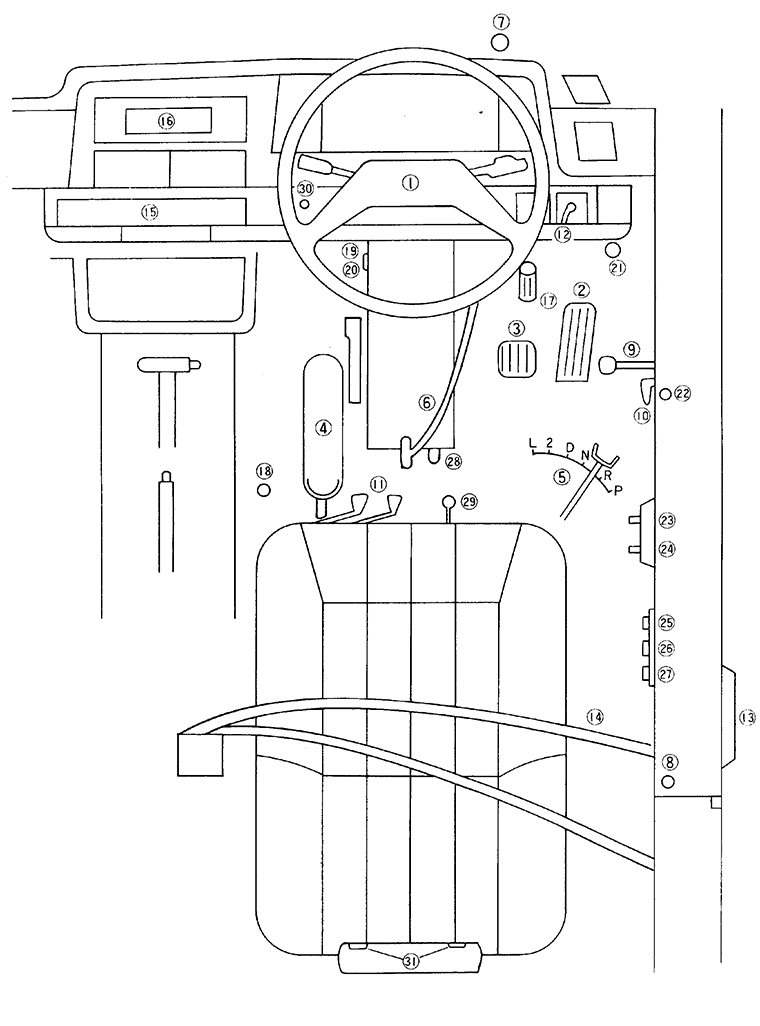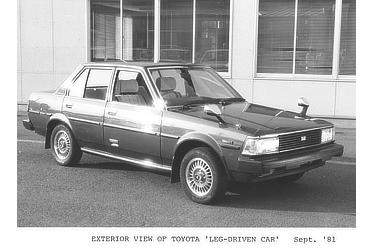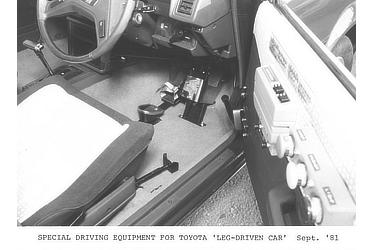Sep. 21, 1981
TOYOTA COMPLETES TEST MODEL OF CAR DESIGNED FOR
DRIVERS WITH HAND OR ARM HANDICAPS
Toyota Motor Co., Ltd. and Toyota Motor Sales Co., Ltd. recently completed a test model of the "Leg-Driven Car," an automobile which can be fully operated without using the arms―the result of a long-term project to develop a vehicle for Thalidomide victims and others who lack or have lost the use of their upper extremities. The new car was first presented to the public today, September 21, in Koganei City in Tokyo at the Ogu Driver's Training Center.
This experimental vehicle is based on the Corolla Sedan 1500SE (with 3-speed automatic transmission and power steering). All parts normally operated with one or both hands have been adapted for control with the legs, head, or verbal commands.
In developing this special vehicle, Toyota modified the Franz System developed by the BBC Company, a West German company which has a distinguished record in creating equipment to aid individuals with upper extremity handicaps. Toyota strove to make its vehicle even easier to drive, by developing its own supplementary equipment for the redesigned Corolla. The cooperation of many handicapped persons was enlisted to conduct repeated driving tests with the vehicle, and many new technological advances have been included in the unique Toyota design.
The major characteristics of this new Toyota vehicle are as follows:
- Driving Operations
All operations formerly handled by the arms have been transferred to other parts of the body. For example,Opening and closing doors to the legs Steering to the left leg
Shifting, switches, parking brake, etc. to the right leg
Turn signal to the head
Air conditioner, radio to verbal commandsAs a result, the vehicle provides exactly the same functions as the original version available to the general public. - A Car That is Easy to Drive
The following Toyota-developed features have been adopted in the "Leg-Driven Car" with the objective of reducing driver fatigue and thereby making the vehicle easy to operate.
- Ignition, headlights, wipers, turn signals, passing signal, parking, hazzard, window washer and other switches are operated by electric buttons. Also adopted was a remote control door lock mechanism, with which doors may be locked or unlocked using a radio signal.
- A voice-recognition system which allows both air conditioner and AM/FM radio to be turned on and off and regulated through verbal commands.
- A light sensor which automatically turns headlights on or off in response to the brightness level outside the car, and also switches over to high or low beams when necessary.
- A speed-sensitive door lock feature which automatically locks the doors when the car exceeds a predetermined speed.
- Automatic seatbelts, which fasten when the driver is seated in the car without any use of the hands or other manual effort.
- Specially designed tires which can be driven for a certain distance even after being punctured, to alleviate the difficulties involved in changing a flat tire without aid.
Toyota considers that enhancing the mobility of handicapped persons is an essential key to promoting their increased participation in society, and to guaranteeing them their equality as human beings. Seeking to contribute to this goal, Toyota has already marketed a "Handycab" version of the Hi-Ace van, which allows persons confined to wheelchairs to board or alight from the vehicle while remaining in their wheelchairs, as well as the "Friend-matic" passenger car series designed for persons with leg handicaps.Toyota plans to make further improvements on the experimental vehicle introduced today, and will donate the first completed model of the higher performance car to Ishizue ("foundation stone" in English), a foundation which looks after the welfare of Thalidomide victims.- Note
- At the present time in Japan, Article 88 of the Road Traffic Act and Article 33 of the Cabinet Order under the Act prohibit persons lacking both upper extremities from obtaining driver's licenses. However, government authorities have displayed a progressive attitude toward authorization of driver's licenses for such handicapped persons, under the condition that safe and appropriate vehicles are developed for them to drive.
SPECIAL DRIVING EQUIPMENT
FOR TOYOTA 'LEG-DRIVEN CAR'

- Power steering
- Accelerator pedal
- Brake pedal
- Crank-type steering
- Select pedal
- Supplementary brake
- Automatic light change sensor
- Speed-sensitive door lock
- Push lever
- Inner handle
- Seat adjustor lever
- Remote control mirror
- Foot-operated outside handle
- Automatic seatbelt
- Automatic air conditioner
- Radio
- Pedal-type parking brake (Switches)
- Handicap functions on/off
- Parking
- Hazzard
- Dimmer
- Door unlock
- Passing
- Horn
- Wiper
- Window washer
- Headlight
- Ignition
- Window regulator
- Emergency
- Turn signal






